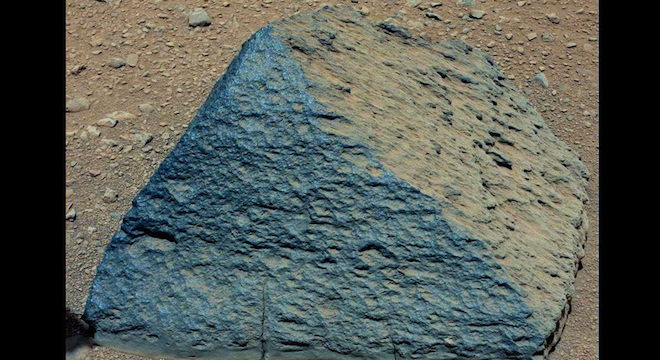A shiny object that NASA’s Mars Curiosity Rover spotted in early October has turned out to be a piece of benign fallen plastic from the rover’s landing gear, but no matter — NASA has unearthed other surprises on the Red Planet: A rock the rover examined and shot with lasers in September has turned up a surprisingly diverse composition and is unlike any previously analyzed from Mars.
NASA examined the rock, named “Jake Matijevic” in honor of a NASA rover engineer who died in August, on September 21 and September 24, using its Chemistry and Camera, or ChemCam instrument — a laser-equipped camera.
NASA fired-off 14 laser shots in two groupings at two select areas of the football-sized rock, indicated in red in the following annotated image provided by NASA on Thursday:

The ChemCam laser pulses excite electrons within a given rock sample, which flash light back at the rover, which receives the light through a telescope and directs it to a spectrometer which in turn, discerns the type of atoms, and thus, elements, that make up the sample.
“ChemCam has seen unexpected observations,” said the instrument’s principal investigator, Roger Wiens of Los Alamos National Laboratory, in a press conference on the latest rover findings Thursday.
Specifically, Curiosity’s ChemCam found that the rock contained “a unique composition for each of the 14 points” examined, as NASA explained in a press release, shattering theories that the rock Jake would be homogenous.
The specific elemental signatures detected by the instrument bounced all around the scale depending on actual site of the laser shots — with some areas showing higher concentrations of magnesium (45-1 in the following diagram) and others evidencing higher concentrations of iron and titanium (45-2):

Mars Curiosity’s science team also used another rover instrument in conjunction with the ChemCam — the Alpha Particle X-ray Spectrometer (APXS) — to establish a more “macro level” view of the rock, looking at two penny-sized locations depicted as purple rings on the first image in this article’s text.
When it looked at the rock, the APXS actually found it was also “quite heterogenous on a large scale,” as APXS principal investigator Ralf Gellert of the University of Guelph in Ontario, Canada, said during Thursday’s press conference.
“This is a new kind of rock type on Mars,” Gellert said.
Though unique in Mars exploration, the rock type is not new to us here on Earth.
Curiosity co-investigator Edward Stolper, a provost and planetary geologist at Caltech, took the data captured by the Curiosity rover and compared to “tens of thousands” of Igneous rocks here on Earth (that is, rocks formed by lava), and what he found was that it came “very close, matching chemical composition to an unusual but well-known kind of Igneous rock that occurs widespread on Earth on oceanic islands, such as Hawai’i and St. Helena and the Azores and also in river stones like the Rio Grande.”
The rock’s formation than “is very close to highly crystallized or fracturized magma on Earth,” as Stolper explained.
Still, Stolper was careful to point out that the rock’s chemical composition and likely formation alone didn’t indicate it had formed in the presence of water, or even through the same specific process as its counterparts on Earth — though Curiosity has independently also seen evidence of an ancient Martian streambed in another area of Mars.
NASA has already moved the rover on from the Jake rock, though, and is now busy scooping sand and using it to clean off Earthly, oily film from the internal equipment on the instruments found on its robotic “hand.”
The rover is currently located at a site called “Rocknest,” and will remain there for the next week or two while it performs further scooping and analysis of Martian soil samples.
Curiosity’s scientists also plan to take even closer imagery of a previously unidentified tiny shiny object found near the foot of the rover (near its wheels) on October 7, which they’ve now all but concluded is a piece of plastic shrink tubing or a bond wrapping some wires from the landing gear that fell off during the descent stage and was inadvertently transported by the rover and knocked off at its current location.
Either way, the Curiosity rover team halted science activities for two days and performed an extensive analysis to ensure that whatever the object is and wherever it came from, it’s “inconsequential” to the rover’s functioning, as NASA Jet Propulsion Laboratory scientist Chris Roumeliotis said in Thursday’s press conference.
The next target is an area of even more seemingly diverse Martian geology called Glenelg, located another 330 feet away, which the Curiosity team aims to perform the first drilling operations on after concluding its work at Rocknest.






